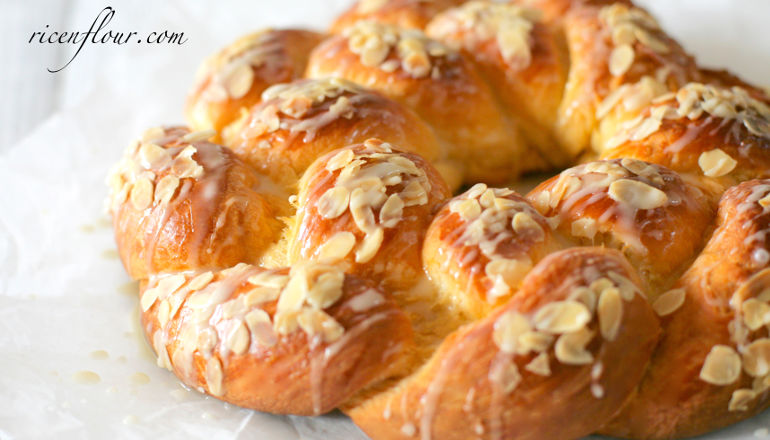I rarely use the word “magical” to describe food, until I was introduced to the taste of the famous Brioche bread – another masterpiece in French kitchen art. The “magical” Brioche is well-known for its especially light, fluffy and soft texture, which tastes almost like a hybrid between bread and cake. This texture derives from a copious proportion of egg and butter content. The butter can account for up to 65% of the flour amount in some recipes. This induces the most incredible taste and smell after being baked.

This Brioche recipe is one of those that I had the luck to learn from Le Cordon Bleu Paris in my French bread baking course last summer. The instructor was among the top-notch pastry chefs in Europe, so there’s probably no need to “advertise” for this recipe any further  . I was actually a bit worried when I tried this recipe at home due to the differences in the ingredients and tools between my home kitchen and LCB professional kitchen. However, the bread turned out awesome from my very first try, confirming that the recipe itself was great and was ready to be introduced to others
. I was actually a bit worried when I tried this recipe at home due to the differences in the ingredients and tools between my home kitchen and LCB professional kitchen. However, the bread turned out awesome from my very first try, confirming that the recipe itself was great and was ready to be introduced to others 
From the original recipe learned from LCB, I made some improvisations to put a new, interesting spin on both the appearance and the taste of my Brioche. I shaped the bread into a wreath that resembled a flower after being baked. The bread was topped with crunchy flaked almonds, accompanied by the sweet and sour flavor from some honey lemon glaze. I also spiced up my bread with a little bit of vanilla extract and Bergamot extract. This mixed flavoring complemented the bread so well, giving it a combination of sweet, tangy and citric aroma, which is delicate yet sexy at the same time.

FRENCH BRIOCHE RECIPE
* PREPARING TIME: 30 – 40 mins plus 15 hours proofing
* BAKING TIME: 30 – 40 mins
* INGREDIENTS
A. Brioche bread
- 250 gram (2 cups) bread flour
- 30 gram (2 tablespoons) caster sugar (can increase to taste)
- 5 gram (1 teaspoon) salt
- 5 gram (1.5 teaspoon) instant dry yeast
- 3 eggs (150 gram – shells excluded)
- 125 gram (1/2 cup or 1 stick plus 1 Tbsp) unsalted butter – softened at room temperature

- 3 ml (1/2 tsp) vanilla extract
- 3 ml (1/2 tsp) bergamot extract (available on sites such as Amazon US here).
- 1 beaten egg for egg wash (can be substituted with water)
- silvered/ sliced almonds for topping
B. Honey lemon glaze
- 45 gram (1/3 cup) icing sugar
- 10 ml (2 tsp) honey
- 10 ml (2 tsp) lemon juice
 Butter is the key ingredient that constitutes the Brioche’s signature rich flavor and texture. The higher your butter’s quality is, the more delicious your bread will be. Therefore, butter shouldn’t be substituted with anything else.
Butter is the key ingredient that constitutes the Brioche’s signature rich flavor and texture. The higher your butter’s quality is, the more delicious your bread will be. Therefore, butter shouldn’t be substituted with anything else.
Method
This recipe has a video tutorial and has been uploaded on my YouTube Channel (Savoury Days Kitchen). If you can’t play the video on this site, you can watch it directly on YouTube via this link.
Note: the video is in HD setting and has English subtitle, please press CC to activate it.
Printable recipe
1. Add into a mixing bowl the bread flour, sugar and salt, and mix well. Then add the instant yeast and mix.
- Note: this recipe requires INSTANT yeast as it has no liquid to activate dry yeast. Be careful when choosing ingredients.
2. Make a well in the middle of the flour mixture, then add in all of the eggs and flavorings to your taste (I use vanilla and bergamot extract).
3. With the dough hooks, start kneading at low speed for 3~4 minutes until all of the ingredients are incorporated and start to form dough.
4. Raise to medium speed and continue kneading for 5~7 minutes until the dough is smooth, quite elastic and pulls away from the side of the bowl. The temperature of the dough should be between 26 and 27 degrees C/ 77 – 80 deg. F. If higher, let the dough cool down at room temperature.
- Note: different types of flour may require different amount of water (i.e., have different hydration level). So if you feel that your dough is too stiff and hard (which means it needs more liquid), you can beat an egg lightly and add this egg into the dough, 1~2 teaspoons at a time and knead until the dough turns soft and smooth. Extra milk is also fine.
5. Add in butter (softened and not melted). Knead at low speed to incorporate butter into the dough, about 3~4 minutes, then raise speed to medium, continue kneading for another 3~5 minutes, until the dough is smooth and shiny. DON’T knead the dough for too long as it will be harder to shape it later on.
6. Wrap the dough with parchment paper and let rest at room temperature (18~23 degrees C/ 64~74 degrees F) for 20~30 minutes.
7. Proof the dough in the fridge, at 2~4 degrees C/ 35~39 degrees F for 12~14 hours. The dough will rise a bit but also gets firm due to the large amount of butter inside, which turns solid under cold temperature.
8. Scale and divide the dough into three parts. Cover them with plastic wrap and put back into the fridge, let them relax there for another 20 minutes.
9. Take the first part out of the fridge (the other two still stay in the fridge). Roll it into a long stick, which is about 35~40 cm long. Repeat with the other two pieces of dough. If the room temperature is higher than 27 degrees C/ 80 degrees F, put the dough back into the fridge after being shaped.
- Note: You can use some dry flour to coat your hands and the counter (to prevent the dough sticking to your hands). However, don’t use too much as it will make the dough slip on the counter. In addition, try to shape the dough as quickly as possible to avoid butter melting.
10. When finish, come back to the first dough. This time, roll it into an approx. 60 cm long strand. This twice-shaping process allows the gluten in the dough to rest and relax for a few minutes; hence, the dough won’t shrink when being shaped. Repeat with the other two pieces of dough.
11. Braid the dough into a 3-strand braid. Then transfer it to a baking tray lined with parchment paper or a silicone baking mat. Connect the two ends of the braid to make a closed circle.
12. Cover the dough with a large proofing box and proof at 20~24 degrees C/ 68~75 degrees F until the dough has doubled in size. It may take 2~3 hours.
* Important notes: As there is quite a lot of butter in Brioche dough, it is crucial to keep an eye on the temperature so that the butter will not melt due to too warm temperature. Some examples are:
- Kneading the dough by machine at a too fast speed for a long time will raise the temperature of the dough.
- Kneading the dough by hand: the warmth from your hands may affect the butter.
- Shaping the dough too slowly in hot temperature with warm hands -> butter may melt.
- Proofing the dough in too warm temperature.
13. Keeping the butter solid is important because if the butter melts, the texture of the final bread will be less fluffy and soft (even thick and dense).
14. Preheat the oven at 170 degrees C/ 338 degrees F – top and bottom heat. When dough has doubled in size, gently apply the egg wash (1 egg lightly beaten) all over the dough. Then put sliced almonds on.
15. Bake the Brioche at 170 degrees C/ 338 degrees F in about 20 minutes then at 160 degrees C/ 320 degrees F in 10 ~ 15 minutes until the bread is golden brown and your kitchen is full of the wonderful buttery smell.
16. If the bread turns dark too fast, you can cover it with a piece of aluminum foil.
17. When the bread is done, take it out of the oven and let it cool down on a rack.
18. Meanwhile, prepare the icing glaze by mixing all of the ingredients including icing sugar, honey and lemon juice in a bowl.
19. When the Brioche has cooled down, use a spoon to pour the honey and lemon glaze over it.
Well-made Brioche should have a dark golden brown crust. The interior can be more or less yellow depending on the color of your butter and egg yolks. The crumb has an extremely tender and moist texture, but also fluffy and stringy – you can pull the bread apart like cotton candy, which is my favorite part about eating it. When you chew on the bread, it melts in your mouth in all its buttery glory.
If you make it right, the Brioche bread can be sealed and stored for 4 days and still tasting nice and soft. You could also seal the bread in a ziplock bag and freeze it, and the bread is good to eat for 6-8 weeks (thaw it in the fridge before eating). And if you can’t finish the whole loaf (which is unlikely for me, considering how good it is) and the bread becomes dry, don’t throw it away because Brioche is the perfect ingredient for the delicious bread pudding.




I have made it using unrefined flour, and I have used 1TBS of milk and a bit more of sugar. 1/2 tsp bergamot was too much in my case, so next time I will use 1/4. Overall, AMAZING result (^.^) Thanks so much for sharing.
Would love to see the original LCB version!
Please give there a easy printable option